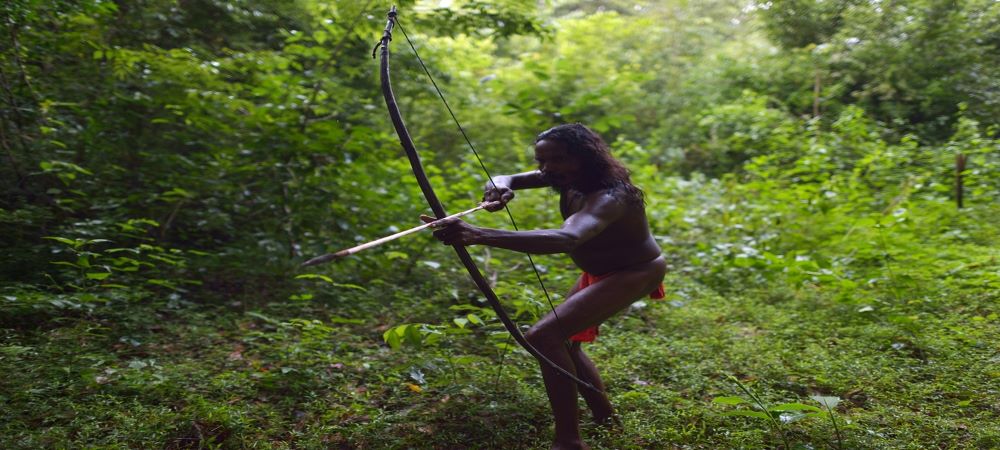The Indigenous People of Sri Lanka, more commonly known as “veddas” are a minority indigenous community in Sri Lanka, a speck of land amidst the bright blue Indian ocean. Considered as the first people or the forebears of this magnificent island, the veddas have a captivating story regarding their origin.
Origin and history
According to the island’s fascinating historical chronicle-The Mahavansa, it is said that the veddas are the children or descendants of Queen Kuveni, a Yaksha and the wife of Sri Lanka’s legendary first King Vijay (5th BC). In order to ascend to the throne King Vijay expelled his queen and children into the forests. With time they learned to live off the jungle eating fruits and hunting animals. After that, the group multiplied into the cultural community we now call as “veddas”.
Hunting methods and Food
Like any other tribal community around the world ,this indigenous group too depend mainly on the jungle for its survival. Veddas were originally hunter-gatherers. They used bows and arrows to hunt game and execute silently, harpoons and toxic plants for fishing and gathered wild plants, yams, honey, fruit and nuts. Many veddas also do farming which specially includes chena cultivation where they cultivate kurakkan, rice and grains.

They being a noble tribal group only kill for food and do not harm the young or pregnant animals .Game is commonly shared between family and clans. Even the poison they use to catch fish are organic and taken from various plants.
The most important natural resource that the Vedda depends on is coconut palm. Coconut palms provide them with fruit throughout the year without fail. The coconut palm doesn’t only provide food but also provides plenty of material to build huts, create shelter, make rope and even bowls to keep things in.
Clothes and livelihood
Until fairly recent times, the clothing of the Veddas was limited. In the case of men, it consisted only of a loincloth suspended with a string at the waist, while in the case of women, it was a piece of cloth that extended from the navel to the knees. Today, however, Vedda attire is more covering, men wear short sarongs while women wear attires which cover them completely.

One of the staple foods gathered by the Vedda is wild honey, which they collect by climbing trees where the hives are and burning dry leaves to ward the bees away. This is a very gruesome yet rewarding activity as bee sting can be very painful but the wild honey tastes very sweet. Every year around June, they go on a two-month long honey hunt, taking only rice and chili with them. The honey collected is used as food, to keep the game fresh and also as a medicine.
The medicines of veddas are not that developed but they have various techniques to treat wounds and broken bones. The ointment they prepare are 100% herbal and environment friendly. They believe in spirits to heal them and guide them towards wellbeing.
Religions, Rituals and burial
Ancient Vedda song and dance are still practiced and passed on to the younger generations. They have a close connection to nature and their ritualistic songs are like a communication with the elements. Tribal shamans speak with the spirits of the dead to make decisions and advise the chief. The Vedda have their own language and some of the Vedda, who want to maintain their culture, are trying to keep it intact by teaching it to their younger children.
The origin of the religion of veddas is animism; which is the belief that objects, places and creatures possess a distinct spiritual essence.

Vedda marriage is a simple ceremony. It consists of the bride tying a bark rope (Diya lanuva) that she has twisted, around the waist of the groom. This symbolizes the bride’s acceptance of the man as her mate and life partner.
Death, too, is a simple affair without ostentatious funeral ceremonies where the corpse of the deceased is promptly buried. At the head of the grave were kept three open coconuts and a small bundle of wood, while at its foot were kept an opened coconut and an untouched coconut. Personal possessions like the bow, arrow, betel pouch were also buried with the body.
Indigenous People-Music
“Bori Bori Sellam-Sellam Bedo Wannita,
Palletalawa Navinna-Pita Gosin Vetenne,
Malpivili genagene-Hele Kado Navinne,
Diyapivili Genagene-Thige Bo Haliskote Peni,
Ka tho ipal denne”
(A Vedda honeycomb cutter’s folk song)
Meaning of this song – The bees from yonder hills of Palle Talawa and Kade suck nectar from the flowers and make the honeycomb. So why should you give them undue pain when there is no honey by cutting the honeycomb(wikipedia)

The vedda lullaby is considered as the oldest lullaby in the world. The tradition is that Kuweni the Yakkha Queen of Vijaya sang this lullaby to lull the children to sleep .This lullaby is artistically designed and its three divisions come to life when the vedda women sing it to lull their babies .The parts are sung to three varying tunes and rhythms.
Visit the Indigenous People
If you’re interested in visiting the Vedda, there are many locations for you to enter the tribal community and explore their divine culture. The tribal chiefs will take you through the community and explain the unique methods they use for their survival enriching you with some valuable historic facts. You can also purchase artifacts; handmade accessories and also fresh wild bee honey bottles directly collected from the jungle.
The veddas, predominantly live in the areas of Dabana and Mahiyanganaya.You can take a tour through the vedda community, learn their methods of hunting and check out their prolonged magnificent history.
Check out cultural tours in Sri Lanka to explore more about Sri Lankan Culture.

